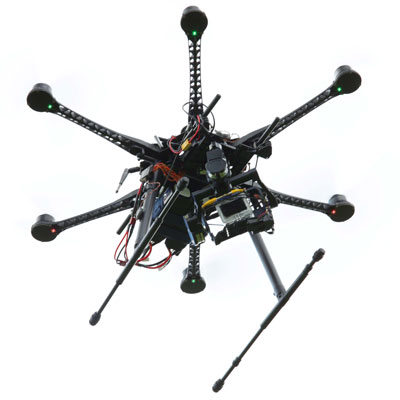May 13 2013
With campus safety and security in mind, engineering students at The University of Alabama in Huntsville are working with the campus police department to perfect unmanned aerial vehicle (UAV) technologies for use on-campus.
 Hobby grade UAV demonstrated in a field near the Wernher von Braun Research Hall on the UAH campus. Credit: Michael Mercier, UAH
Hobby grade UAV demonstrated in a field near the Wernher von Braun Research Hall on the UAH campus. Credit: Michael Mercier, UAH
"The UAH Police Department is pleased to be associated with the Systems Management and Production Center in a partnership that is exploring realistic and effective uses for small UAVs in day to day law enforcement and security operations on the campus," said Chief Michael Snellgrove. "We believe the technology may be incredibly useful and offers us a wide range of possible applications. We intend to review these applications and look for every possible way to take advantage of the available technology. Ultimately our objective is to enhance our ability to make UAH an even more secure place to study, live, work and visit."
The research being conducted by UAH is led by the Systems Management and Production Center (SMAP). SMAP Director Dr. Gary Maddux cites the tragedy of the Sandy Hook massacre as the catalyst for the effort.
"There have been far too many shootings - Columbine, Virginia Tech and Newtown - and our work is an attempt to apply sensor, modeling and UAV technologies to law enforcement to improve response time," Dr. Maddux said. "Our goal is not only to provide a safer campus at UAH, but to enhance the state of a technology that can be affordably applied to other schools and localities."
Led by Steven Forney, a SMAP research associate, student designers are working with police to develop UAVs using a combination of university designed and off the shelf technologies that would aid the university in the event of a disaster, fire or on-campus criminal offense, said Norven Goddard, a principal research scientist with SMAP.
"This is probably one of the first times when law enforcement on a campus is working directly with engineers to tailor a product to fit their needs," Goddard said. The relationship allows the police input on the primary development phase of the product, rather than requesting changes to a product already released.
Versions so far include UAV attachments that mount a small camera for surveillance, an LED flashlight/spotlight and camera for night spotlighting or an infrared camera to detect heat signatures. Students are also working on mapping the campus with the goal of providing a campus-wide fly zone for near-automatic operation of the UAVs and a means by which the UAVs can recognize campus buildings by their 3-D images.
Currently the technology is controlled outdoors, but SMAP engineers are working on a system in which campus UAVs could be operated remotely from inside a building.
"We're trying to train students in looking at the crystal ball, what things could look like in the future," Goddard said. Innovators of that type are in high demand, he said, and the work fits the SMAP goals of providing a real-world work environment for engineering students who plan to have careers in defense and aerospace.